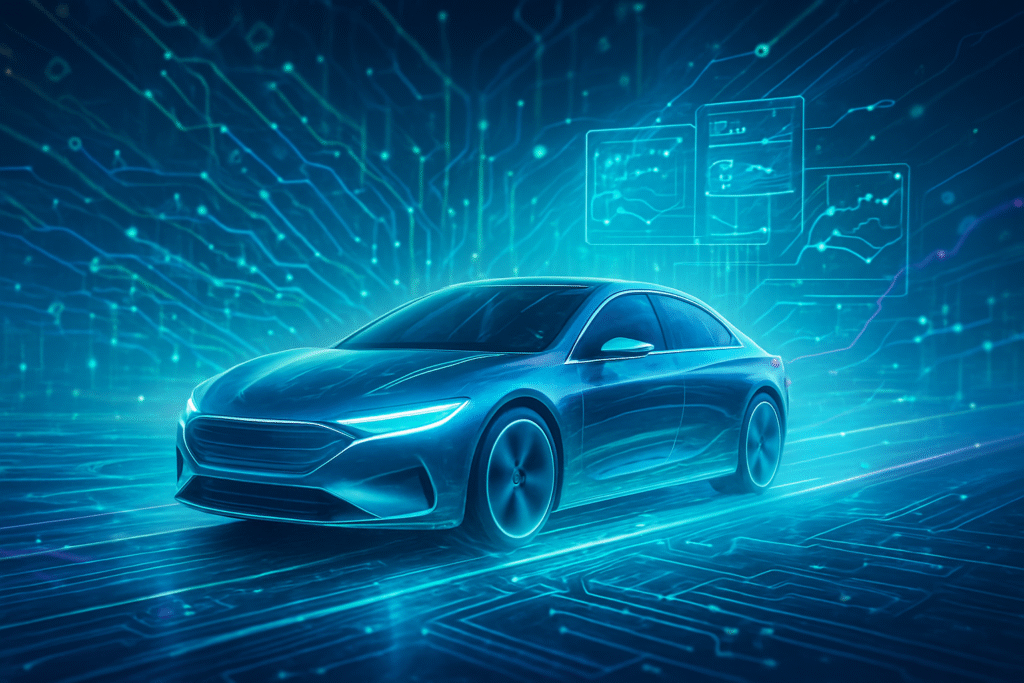
Semiconductors have transcended their role as mere electronic components to become the indispensable foundation of the modern automotive industry. These tiny, yet powerful, chips are orchestrating a profound transformation, turning conventional vehicles into sophisticated, software-defined computing platforms. Their immediate significance lies in enabling everything from fundamental in-car electronics and advanced safety features to the cutting-edge realms of autonomous driving and electric vehicle efficiency, fundamentally reshaping how we interact with and perceive mobility.
This pervasive integration of semiconductor technology is not just an incremental improvement; it is the core engine behind over 90% of automotive innovations, dictating the pace and direction of future developments. As the industry hurtles towards an era of fully autonomous, electric, and hyper-connected vehicles, the strategic importance of semiconductors continues to escalate, making them the ultimate determinant of a car's intelligence, safety, and performance.
The Microscopic Engineers: Diving into Automotive Semiconductor Technology
The automotive industry's metamorphosis into a high-tech sector is directly attributable to the diverse and specialized semiconductor applications embedded within every vehicle. Modern cars are veritable networks of these chips, ranging from 1,000 to 3,500 per vehicle, with electric vehicles (EVs) and autonomous platforms demanding even higher densities. These semiconductors fall into several critical categories, each with distinct technical specifications and roles.
Microcontrollers (MCUs) serve as the ubiquitous control centers, managing myriad functions from basic door locks (8-bit MCUs like Microchip PIC18-Q83/84) to complex engine and transmission control (32-bit MCUs featuring ARM Cortex-M or Renesas RH850, often utilizing advanced 28nm FD-SOI technology for efficiency). Power semiconductors, particularly crucial for EVs, handle power conversion and management. Traditional Insulated-Gate Bipolar Transistors (IGBTs) convert DC to AC for motors, while newer Wide-Bandgap (WBG) materials like Silicon Carbide (SiC) and Gallium Nitride (GaN) are revolutionizing efficiency. SiC, capable of handling up to 1700 volts, reduces energy loss by up to 50% in EV inverters, while GaN, ideal for onboard chargers and DC-DC converters, offers faster switching and higher thermal conductivity.
Sensors and their interfaces are the vehicle's eyes and ears, relying on semiconductors to process vast data streams from LiDAR, radar, cameras, and ultrasonic sensors for ADAS and autonomous driving. AI accelerators and Systems-on-Chip (SoCs), like NVIDIA's (NASDAQ: NVDA) DRIVE platform or AMD's (NASDAQ: AMD) Versal AI Edge XA family, deliver massive processing power (e.g., up to 171 TOPS of AI performance) for real-time decision-making in autonomous systems. Communication chips, including automotive Ethernet and 5G/V2X modules, ensure high-speed, low-latency data exchange within the vehicle and with external infrastructure. This intricate web of silicon has propelled a fundamental architectural shift from fragmented, distributed Electronic Control Units (ECUs) to integrated domain and zonal controllers, significantly reducing wiring complexity and enabling software-defined vehicles (SDVs) with over-the-air (OTA) updates.
Initial reactions from both the automotive and semiconductor industries underscore this profound shift. Automakers like Tesla (NASDAQ: TSLA) are increasingly designing their own chips (e.g., AI5) to gain design control and supply chain resilience, recognizing semiconductors as a core strategic asset. The global chip shortage (2021-2023) further solidified this perspective, prompting robust partnerships with semiconductor giants like Infineon (ETR: IFX), NXP Semiconductors (NASDAQ: NXPI), and STMicroelectronics (NYSE: STM). Semiconductor companies, in turn, are heavily investing in specialized, automotive-grade chips that meet stringent quality standards (ISO 26262 functional safety, -40°C to 125°C operating temperatures) and see the automotive sector as a primary growth driver, with the market projected to exceed $160 billion by 2032.
Reshaping the Landscape: Industry Impact and Competitive Dynamics
The escalating reliance on semiconductors, particularly those infused with AI capabilities, is creating a dynamic and highly competitive landscape across the automotive and technology sectors. This symbiotic relationship, where advanced chips enable more sophisticated AI and AI drives demand for even more powerful silicon, is reshaping market positioning and strategic advantages for a diverse array of players.
Traditional semiconductor manufacturers like NVIDIA (NASDAQ: NVDA), TSMC (NYSE: TSM), Samsung (KRX: 005930), Infineon (ETR: IFX), NXP (NASDAQ: NXPI), and Qualcomm (NASDAQ: QCOM) are clear beneficiaries, experiencing surging demand for their specialized automotive-grade processors, power management units, and memory solutions. NVIDIA's GPUs, for instance, are pivotal for both training AI models in data centers and powering autonomous driving systems in vehicles. Simultaneously, a vibrant ecosystem of AI chip startups, such as Hailo, Kneron, and Black Sesame Technologies, is emerging, developing highly optimized edge AI solutions for computer vision and ADAS, challenging established players with innovative, power-efficient designs. Tech giants like Tesla (NASDAQ: TSLA), Google (NASDAQ: GOOGL), and Amazon (NASDAQ: AMZN) are also increasingly designing custom silicon to optimize for their unique AI workloads and reduce external dependencies, signaling a trend towards vertical integration.
This intense competition is driving significant disruption. The shift to software-defined vehicles (SDVs), enabled by advanced semiconductors, is fundamentally altering the value proposition of a car, with software's share of vehicle cost projected to double by 2030. This creates immense opportunities for AI software and algorithm developers who can build robust platforms for sensor fusion, decision-making, and over-the-air (OTA) updates. However, it also poses challenges for traditional automotive suppliers who must adapt their business models. The recent chip shortages underscored the fragility of global supply chains, pushing automakers to forge closer, long-term partnerships with chipmakers and even consider in-house chip design to ensure resilience. Companies with diversified supply chains and strong relationships with foundries like TSMC (NYSE: TSM) and Samsung (KRX: 005930) are better positioned to navigate future volatilities.
Market positioning is increasingly defined by the ability to deliver scalable, high-performance, and energy-efficient AI-centric architectures. Companies focusing on specialized chips like ASICs and NPUs for edge AI, alongside comprehensive software capabilities that enable flexible AI models and OTA updates, are gaining strategic advantages. The automotive semiconductor market is projected to exceed $88 billion by 2027, with AI chips in automotive seeing a significant compound annual growth rate (CAGR) of nearly 43% through 2034, underscoring the critical importance of these strategic investments and collaborations.
Beyond the Dashboard: Wider Significance and Societal Implications
The profound integration of semiconductors into the modern automotive industry carries a wider significance that extends far beyond vehicle performance, deeply influencing the broader AI landscape and societal norms. This convergence marks a pivotal trend in AI, where highly specialized hardware is becoming indispensable for realizing the full potential of artificial intelligence in real-world, safety-critical applications.
Within the broader AI landscape, automotive semiconductors are driving the crucial trend of "edge AI," enabling complex AI processing to occur directly within the vehicle rather than relying solely on cloud connectivity. This necessitates the development of powerful yet energy-efficient Neural Processing Units (NPUs) and modular System-on-Chip (SoC) architectures. The automotive sector's demand for real-time, safety-critical AI processing is pushing the boundaries of chip design, influencing advancements in AI accelerators, sensor fusion technologies, and robust software frameworks. This makes the automotive industry a significant proving ground and driver of innovation for AI, mirroring how other sectors like mobile computing and data centers have historically shaped semiconductor development.
Societally, the impact is multifaceted. On the positive side, AI-powered ADAS features, enabled by sophisticated chips, are demonstrably enhancing road safety by reducing human error, leading to fewer accidents and fatalities. Autonomous vehicles promise to further revolutionize mobility, offering increased accessibility for non-drivers, optimizing traffic flow, and potentially reducing congestion and energy consumption. AI also contributes to environmental benefits by improving the efficiency of electric vehicles and enabling smarter energy management. However, these advancements also introduce significant concerns. Ethical AI dilemmas arise in "no-win" accident scenarios, where autonomous systems must make life-or-death decisions, raising questions about accountability and programming biases. Data privacy is a major concern, as connected vehicles collect vast amounts of personal and operational data, necessitating robust cybersecurity measures to prevent misuse or theft. The energy consumption of powerful onboard AI computers also presents an environmental challenge, with projections suggesting that a global fleet of autonomous vehicles could consume energy comparable to all data centers today.
Compared to previous AI milestones, the current automotive AI revolution stands out due to its reliance on specialized hardware for real-time, safety-critical applications. Earlier AI breakthroughs often leveraged general-purpose computing. In contrast, today's automotive AI demands purpose-built GPUs, ASICs, and NPUs to process immense sensor data and execute complex decision-making algorithms with unparalleled speed and reliability. This shift from automation to true autonomy, coupled with the sheer complexity and comprehensive integration of AI into every vehicle system, represents a leap that transforms the car into a software-defined computing platform, pushing the frontiers of AI development into a domain where reliability and safety are paramount.
The Road Ahead: Future Developments and Expert Predictions
The trajectory of semiconductors in the automotive industry points towards an even more integrated, intelligent, and efficient future, driven by continuous innovation in materials, architectures, and AI capabilities. Near-term and long-term advancements are poised to redefine the driving experience and the very nature of vehicles.
In the near term, the widespread adoption of Wide-Bandgap (WBG) semiconductors, particularly Silicon Carbide (SiC) and Gallium Nitride (GaN), will accelerate. SiC is expected to dominate power electronics in 800V and higher voltage EV systems by 2030, offering superior efficiency, extended range, and faster charging. GaN, while earlier in its automotive journey, is gaining traction for onboard chargers and power inverters, promising even greater efficiency and miniaturization. The shift towards centralized computing architectures, consolidating multiple ECUs into powerful domain and zonal controllers powered by high-performance Systems-on-Chip (SoCs), will continue to simplify vehicle wiring, enhance scalability, and enable seamless over-the-air (OTA) updates. Advanced sensor technologies, including more precise 77-81 GHz radar, integrated solid-state LiDAR, and enhanced vision systems, will become more sophisticated and cost-effective, fueling higher levels of autonomous driving.
Looking further ahead, potential applications include fully autonomous mobility-as-a-service (MaaS) fleets, highly personalized in-cabin experiences driven by advanced AI, and pervasive Vehicle-to-Everything (V2X) communication facilitated by 5G and future 6G networks, enabling real-time traffic optimization and accident prevention. In-cabin sensing, using cameras and UWB, will evolve to provide sophisticated driver monitoring and occupant detection for enhanced safety and comfort. Predictive maintenance, powered by AI-enabled semiconductors, will allow vehicles to self-diagnose issues and proactively schedule servicing. However, significant challenges remain. Manufacturing capacity and raw material sourcing for advanced chips, particularly for older technology nodes, continue to be a concern, necessitating strategic investments and diversified supply chains. Interoperability between complex software and hardware systems, along with the high costs of cutting-edge materials like SiC, also needs to be addressed for broader adoption.
Experts predict a sustained surge in automotive semiconductor content, with the average value per vehicle projected to increase by 40% to over $1,400 by 2030. EV production is expected to represent over 40% of total vehicle production by 2030, serving as a massive demand driver for semiconductors. The automotive chip market is forecast to reach nearly $149 billion by 2030. Strategic partnerships between automakers and chipmakers, like Tesla's (NASDAQ: TSLA) recent $16.5 billion agreement with Samsung (KRX: 005930) for AI6 automotive chips, will become more common, alongside a growing trend towards in-house chip design to secure supply and optimize performance. The development of chiplet architectures, offering modularity and scalability, is also a key area to watch, promising more flexible and cost-effective solutions for future vehicle platforms.
The Intelligent Core: A Comprehensive Wrap-up
Semiconductors are unequivocally the strategic core of the modern automotive industry, serving as the essential building blocks for the ongoing revolution in mobility. From orchestrating fundamental vehicle functions to powering the intricate algorithms of autonomous driving, these tiny chips dictate the intelligence, safety, and efficiency of every modern car. Their pervasive integration has transformed vehicles into sophisticated, software-defined machines, marking a profound and indelible chapter in both automotive engineering and the broader history of artificial intelligence.
The significance of this development in AI history cannot be overstated. The automotive sector's relentless demand for real-time, safety-critical AI processing has accelerated the development of specialized AI accelerators, robust sensor fusion technologies, and advanced edge computing capabilities. This has pushed AI beyond theoretical models into tangible, mass-produced applications that directly impact human lives, making the car a crucial proving ground for next-generation AI. The shift from distributed, hardware-centric architectures to centralized, software-defined platforms, enabled by powerful semiconductors, represents a fundamental re-imagining of vehicle design and functionality.
Looking long-term, the impact is transformative. We are moving towards a future of enhanced safety, reduced congestion, and personalized mobility experiences, all underpinned by increasingly sophisticated silicon. The growth of electric vehicles, autonomous driving, and connected car technologies will continue to drive exponential demand for advanced semiconductors, with the automotive semiconductor market projected to reach nearly $149 billion by 2030. However, this trajectory is not without its challenges. Ensuring resilient supply chains, addressing the high costs of cutting-edge materials, resolving interoperability complexities, and mitigating ethical, privacy, and cybersecurity risks will be paramount.
In the coming weeks and months, industry watchers should closely monitor key developments: the continued diversification and localization of semiconductor supply chains, especially for critical automotive-grade chips; further innovations in WBG materials like SiC and GaN; the deepening of strategic partnerships between automakers and chip manufacturers; and the evolution of chiplet architectures for greater flexibility and scalability. The continuous rollout of new automotive semiconductor solutions, such as Bosch's (ETR: BOSCH) Automotive Edge Computing platform and Infineon's (ETR: IFX) latest microcontrollers, will offer tangible insights into the industry's direction. Ultimately, the story of the modern car is increasingly the story of its semiconductors, and their ongoing evolution will determine the future of transportation.
This content is intended for informational purposes only and represents analysis of current AI developments.
TokenRing AI delivers enterprise-grade solutions for multi-agent AI workflow orchestration, AI-powered development tools, and seamless remote collaboration platforms.
For more information, visit https://www.tokenring.ai/.





